Signals Intelligence (SIGINT) Market Research Insights: 2030
The global signals intelligence (SIGINT) market size was valued at USD 15.5 billion in 2021, and is projected to reach USD 23.3 billion by 2030, growing at a CAGR of 4.5% from 2022 to 2030.
National security is the security of a nation-state and is regarded as government duty. It includes safety of the citizens, economy, and institutions of the country. National security is a critical priority in many countries around the world, and it necessitates a large budget to build and maintain. The total global military expenditure in 2018 was approximately USD 1.8 trillion, a 2.6 percent increase over 2017.
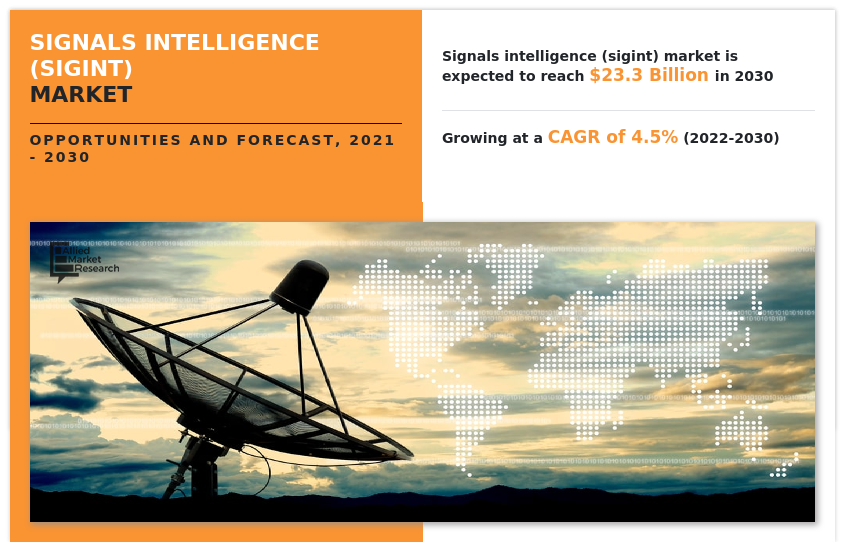
The US spends more money on defense than another seven countries combined. The United States spent USD 649 billion on defense in 2018, while India, France, China, the United Kingdom, Saudi Arabia, Russia, and Germany spent USD 609 billion each. Ministry of Defence is the third most powerful government organisation in the United States, after Social Security and Medicare. This same United States has historically spent more on defense than any other G-7 country. However, due to budgetary constraints and a lack of skilled personnel, militaries face a constant challenge in adopting advanced and innovative technologies and products. Budget constraints frequently impede the implementation of advanced communication systems.
The global SIGINT market is segmented on the basis of type, solution and region. By type, the market is classified into ELINT and COMINT. By solution market is classified into airborne, ground, naval, cyber, and space. By mobility the market has been categorized into fixed and man portable. By region, the market is analyzed across North America, Europe, Asia-Pacific, and LAMEA.
Sement Overview:
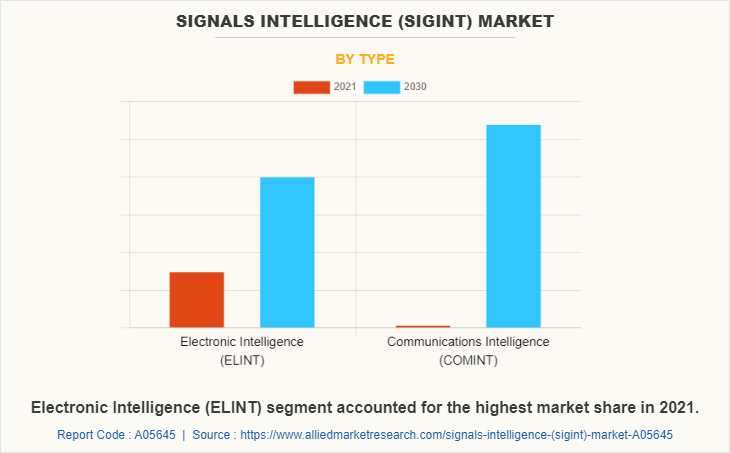
By type, COMINT sub-segment had the highest market share in 2021, and it is projected to remain the dominant sub-segment during the forecast period. Communications intelligence (COMINT) is data gathered from people's communications, such as via phone calls, text messages, and various types of online interactions. In order to identify a wide range of intelligence factors, COMINT efforts look for information about voice, message, and message transmissions. Moreover, electronic communication held the highest signal intelligence market share over the forecast period.
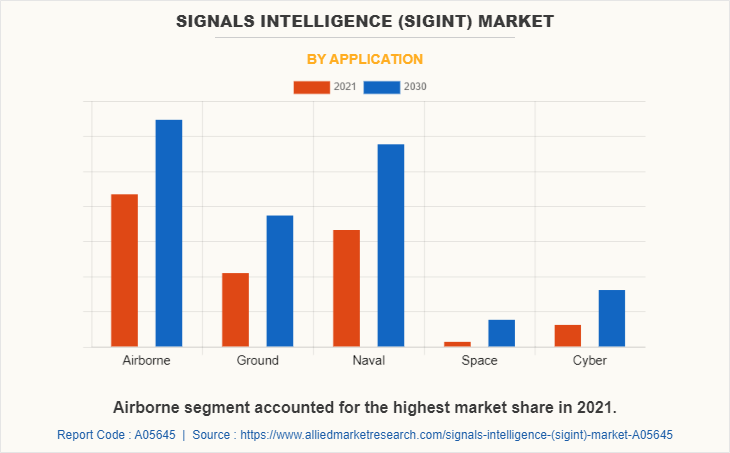
By solution, the airborne signal intelligence (SIGINT) sub-segment had the largest market share by solution in 2021, and it is expected to remain the dominant sub-segment throughout the forecast period. SIGINT solutions help achieve universal situational awareness, air-force management, and comprehensive collaborative mission planning. Furthermore, the solutions are critical in real-time decision making. These factors are propelling the signals intelligence market over the forecast period.
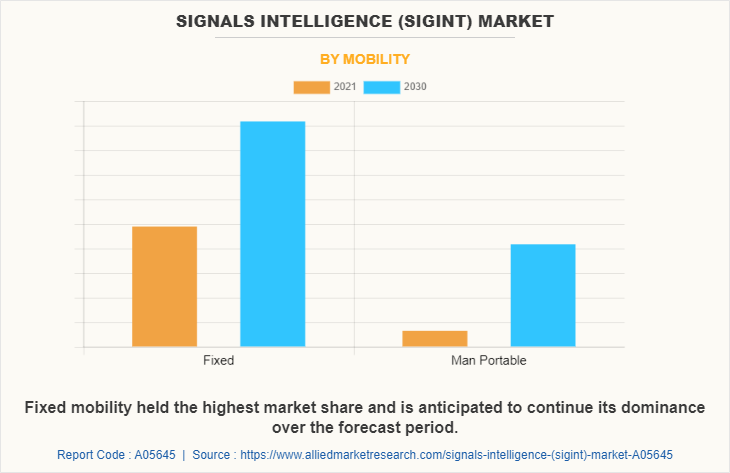
By mobility, the fixed signal intelligence sub-sgement held the largest signals intelligence market share in 2021, and is anticiapted to continue its dominance over the forecast period. On the battlefield, fixed mobility has a tactical advantage. These systems allow soldiers to intercept radio frequency signals, learn from foreign instrumentation signals, and carry out signal direction finding utilising voice and communication data. They are installed on a multipurpose wheeled vehicle. Enemies are therefore unaware that they are being watched since systems are resilient. the rising demand for such cutting-edge technology that gather data about enemies through their communication networks, such as voice or text messaging. is anticipated to propel the signals intelligence market growth over the forecast period.
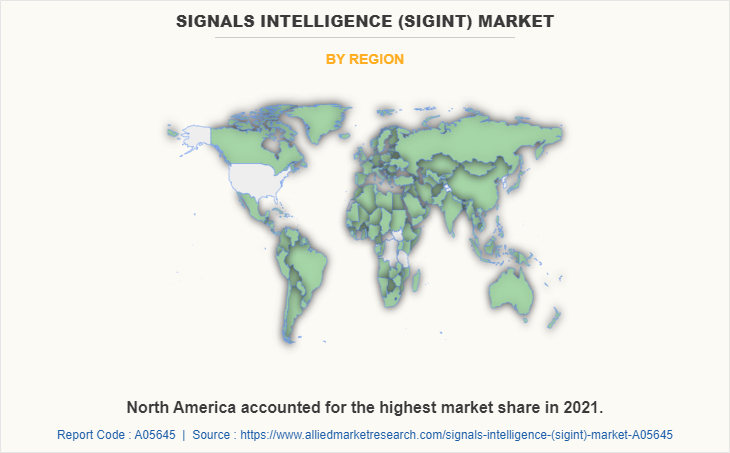
By region, Asia-Pacific is projected to be the fastest growing market during the forecast period. The Asia-Pacific (APAC) signals intelligence market is expanding at an exponential rate, owing primarily to rising security and border threats from neighboring countries. Technological advances and rapid economic development in China, India, Russia, and South Korea have contributed to increased investment in the APAC signals intelligence market. APAC's fast-growing economies are strengthening their defenses.
Technological advancements in SIGINT solutions and systems in APAC also provide opportunities for signals intelligence market growth. During the forecast period, the APAC region's SIGINT is expected to grow at the fastest CAGR. This expansion can be attributed to increased funding/investment by regional countries in the development of SIGINT products. Furthermore, both international and domestic players have increased their focus over the development of signal intelligence services across the globe.
Competition Analysis:
The key players profiled in signals intelligence (SIGINT) Industry report include BAE Systems., Thales Group, Northrop Grumman Corporation., Lockheed Martin Corporation., Raytheon Technologies Corporation, Elbit Systems Ltd., General Dynamics Corporation, Rheinmetall AG, L3Harris Technologies, Inc., and Mercury Systems, Inc.
Key Benefits for Stakeholders:
- The report provides an in-depth analysis of the global signals intelligence market trends along with the current and future market forecast.
- This report highlights the key drivers, opportunities, and restraints of the market along with the impact analyses during the forecast period.
- Porter’s five forces analysis helps analyze the potential of the buyers & suppliers and the competitive scenario of the global signals intelligence (SIGINT) market for strategy building.
- A comprehensive global signals intelligence market analysis covers factors that drive and restrain the market growth.
- The qualitative data in this report aims on market dynamics, trends, and developments which helps in understanding the signals intelligence signals intelligence market forecast.
Signals Intelligence (SIGINT) Market Report Highlights
| Aspects | Details |
| By Type |
|
| By Application |
|
| By Mobility |
|
| By Region |
|
| Key Market Players | Lockheed Martin Corporation, Northrop Grumman Corporation, Raytheon Company, Elbit Systems Ltd., Mercury Systems Inc., Rheinmetall AG, General Dynamics Corporation, Thales Group, BAE Systems, Harris Corporation |
Analyst Review
According to the CXOs of the leading companies, the global signals intelligence (SIGINT) market possesses a substantial scope for growth in the future. The major factors driving the growth of the signals intelligence (SIGINT) market are increase in terrorism, increase in major countries' defense budgets around the world, and the modernization or replacement of an ageing defense system. Furthermore, the increased adoption of electronic intelligence across a variety of industries fuels the growth of the SIGINT market. However, the high cost of signal intelligence deployment and the software's inability to address multiple threats limit market growth. Furthermore, the increased availability of signals intelligence in the public domain is expected to provide significant opportunities for the SIGINT market. According to the CXOs, Asia-Pacific is projected to register faster growth as compared to North American and European markets.
The global signals intelligence (SIGINT) market size was valued at $15.5 billion in 2021, and is projected to reach $23.3 billion by 2030
The signals intelligence (SIGINT) market is projected to grow at a compound annual growth rate of 4.5% from 2022 to 2030.
The key players that operate in the cloud gaming market such as BAE Systems., Thales Group, Northrop Grumman Corporation., Lockheed Martin Corporation., Raytheon Technologies Corporation, Elbit Systems Ltd., General Dynamics Corporation, Rheinmetall AG, L3Harris Technologies, Inc., and Mercury Systems, Inc. are the leading market players active in the Signals intelligence (SIGINT) market.
Asia-Pacific will provide more business opportunities for global signals intelligence (SIGINT) market in the future.
The key factors driving the market of the Signals intelligence market are an increase throughout terrorism, a rise in major countries' defence budgets all around world, and the industrialization or substitute of an ageing defence system are expected to drive the adoption of Signal intelligence (SIGINT).
Loading Table Of Content...



